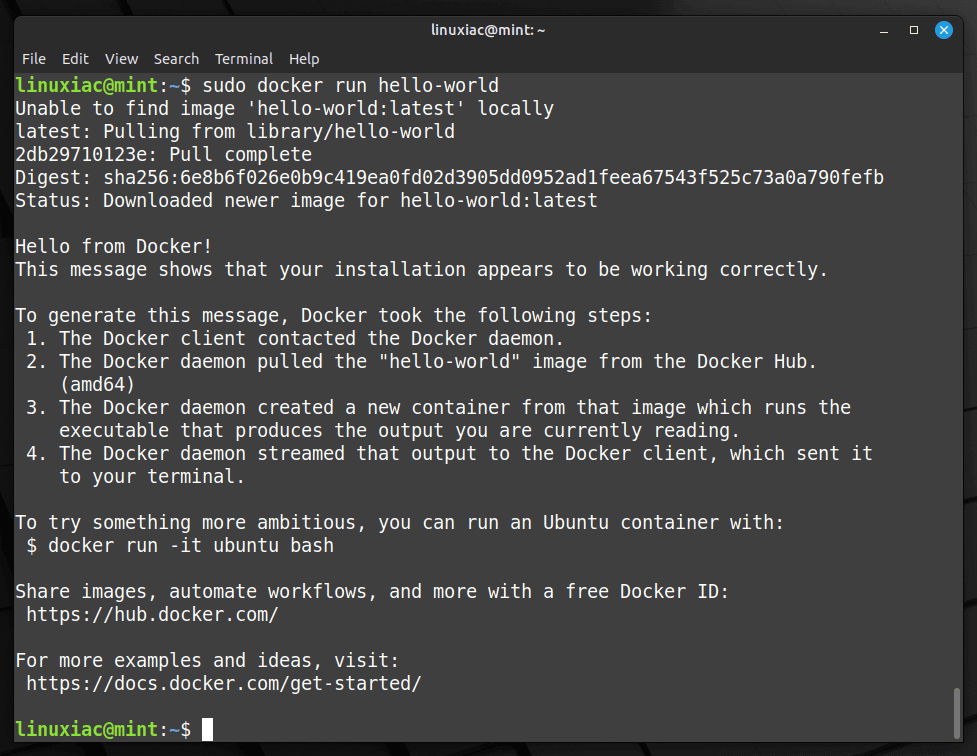Docker is a popular containerization platform that allows developers to create, deploy, and run applications in a portable and efficient manner. It simplifies the process of packaging applications and their dependencies into self-contained units called containers, which can run on any Linux-based operating system.
In this article, we will explore how to install Docker on Linux Mint 21, step-by-step. Whether you are a developer, sysadmin, or just getting started with Docker, this guide will help you get up and running with Docker on your Linux Mint 21 system in no time.
However, if you came across this guide looking for one for Linux Mint 22, you can find it here.
Installing Docker on Linux Mint 21
You can install Docker on your Linux Mint 21 system in several ways. For example, it is available in the official Mint repositories, where users can easily install it with a single APT command. However, one disadvantage to this approach is that the version available is not always the most recent.
For this reason, this guide will show you how to install Docker on Linux Mint 21 from the official Docker repository so you always get the latest version, and it will automatically receive all future software updates as they become available. So, let’s get started.
Step 1: Install Prerequisites
First, run the two commands below to update the package index and install the prerequisite necessary to add and use a new HTTPS repository.
sudo apt update
sudo apt install apt-transport-https ca-certificates curl gnupgCode language: Bash (bash)Once operations are completed, you can move to the next section, where we’ll add the Docker’s repo GPG key and repo itself to our Linux Mint 21 system.
Step 2: Add Docker’s Official GPG Key
Next, import the Docker GPG repository key to your Mint system. This security feature ensures that the software you’re installing is authentic.
curl -fsSL https://download.docker.com/linux/ubuntu/gpg | sudo gpg --dearmor -o /usr/share/keyrings/docker.gpgCode language: Bash (bash)
Notice that the command produces no output.
Step 3: Add Docker Repo to Linux Mint 21
After importing the GPG keys, we’ll add the official Docker repository to our Linux Mint 21 system. This implies that the update package will be made available with the rest of your system’s regular updates if a new version is released.
echo "deb [arch=$(dpkg --print-architecture) signed-by=/usr/share/keyrings/docker.gpg] https://download.docker.com/linux/ubuntu jammy stable" | sudo tee /etc/apt/sources.list.d/docker.list > /dev/nullCode language: Bash (bash)
As with the previous command, its execution produces no output.
Next, refresh the package list.
sudo apt updateCode language: Bash (bash)
This command updates the package index on our system. As you can see, the newly added Docker repository is now available and ready to be used.
Step 4: Install Docker on Linux Mint 21
Finally, run the below command to install the latest up-to-date Docker release on Linux Mint.
sudo apt install docker-ce docker-ce-cli containerd.io docker-buildx-plugin docker-compose-pluginCode language: CSS (css)
This installs the following Docker components:
- docker-ce: The Docker engine itself.
- docker-ce-cli: A command line tool that lets you talk to the Docker daemon.
- containerd.io: A container runtime that manages the container’s lifecycle.
- docker-buildx-plugin: A CLI plugin that extends the Docker build with many new features.
- docker-compose-plugin: A configuration management plugin to orchestrate creating and managing Docker containers through compose files.
That’s all! Docker should now be installed; the service started and enabled to start automatically on boot.
In addition, you can check the Docker service status using the following:
sudo systemctl is-active dockerCode language: Bash (bash)
Step 5: Verify the Docker Installation
Now let’s check if everything with our new Docker installation works properly. For this purpose, we will run a simple application called “hello-world.”
sudo docker run hello-worldCode language: Bash (bash)
Congratulations! As we can see, everything works as expected!
Enabling Non-root Users to Run Docker Commands
So far, we have successfully installed Docker on your Linux Mint 21 system.
However, only root and users with sudo privileges can execute Docker commands by default, which can be a security concern. In other words, if you attempt to run the docker command as a regular user without prefixing it with sudo, you’ll get an error message like this:

So, to run Docker commands as a non-root user, you must add your user to the docker group. To do that, type in the following:
sudo usermod -aG docker ${USER}Code language: Bash (bash)In the above command, ${USER} is an environment variable that holds your username. To apply for the new group membership, reboot your Mint system. You can then execute docker commands without prefixing them with sudo.

This approach can reduce the security risks associated with Docker while enabling non-root users to take advantage of its powerful capabilities.
Conclusion
Installing Docker on Linux Mint 21 can initially seem daunting, but with the step-by-step guide provided, it is a relatively straightforward process. Following the steps outlined in the guide, you can successfully install Docker on your Linux Mint 21 machine and start reaping the benefits of containerization.
So, what are you waiting for? Start experimenting with Docker today and see how it can revolutionize how you build and deploy applications.
Let me know if you have any questions or suggestions, and I’ll be happy to follow up with you. Happy dockering!
To learn more about Docker, check out the official Docker documentation.
